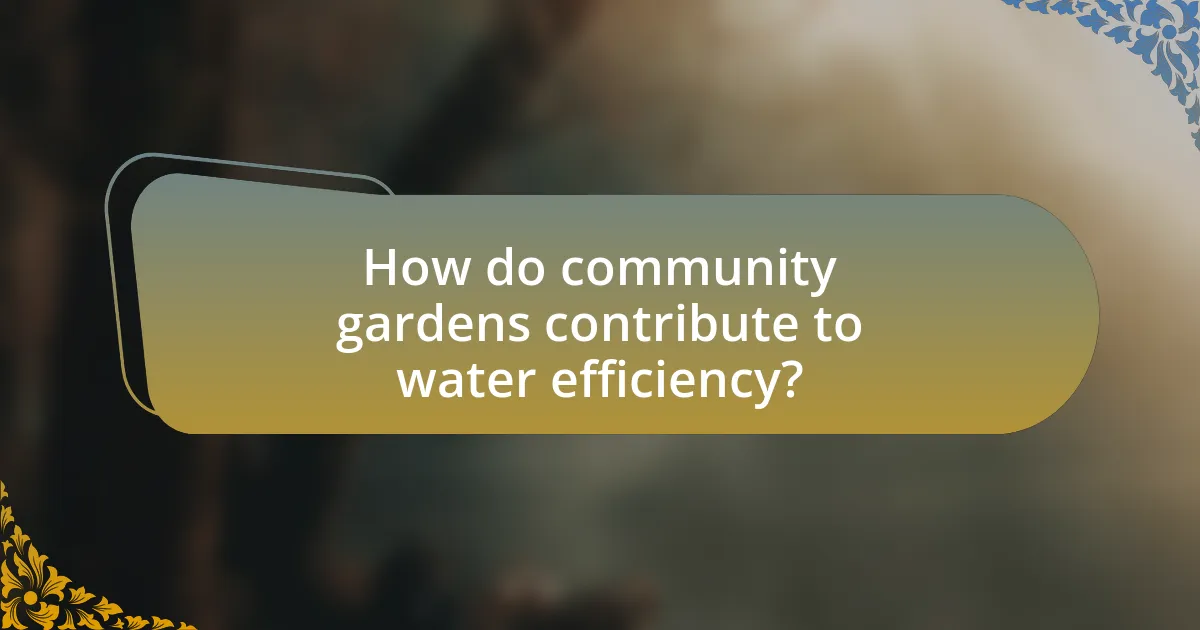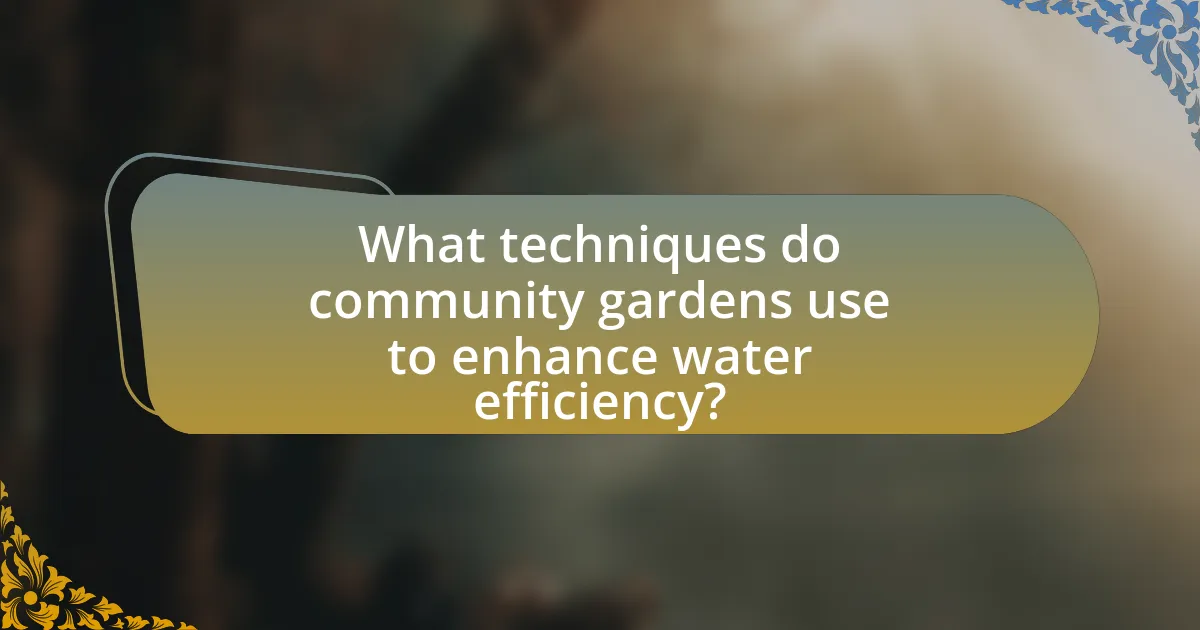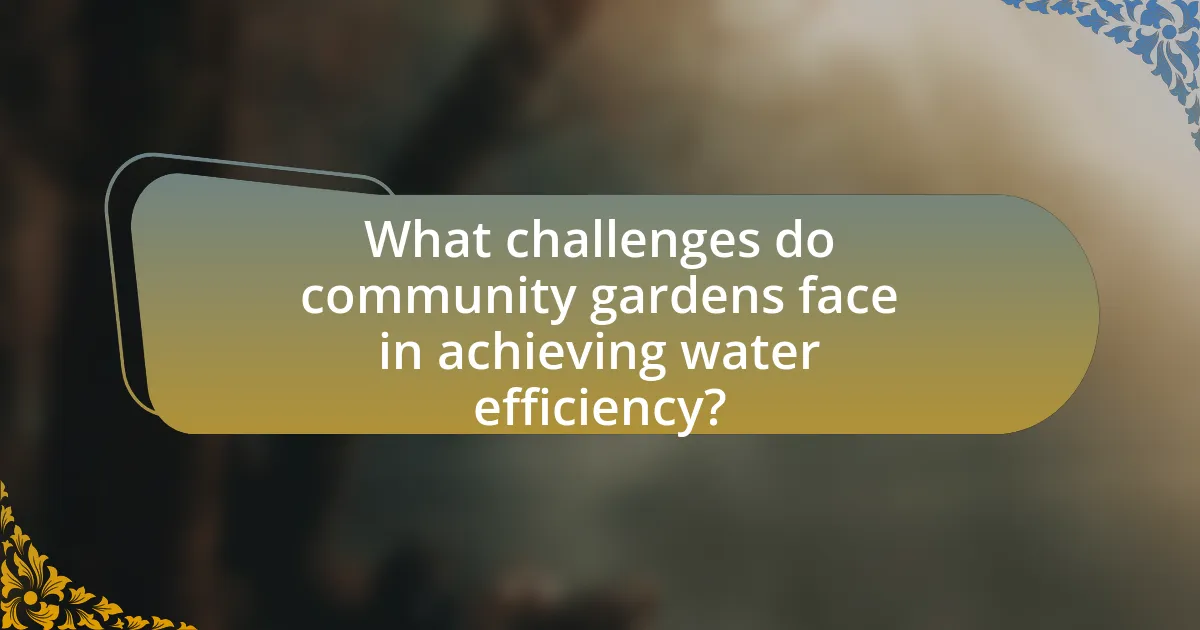Community gardens play a vital role in enhancing water efficiency through various sustainable practices such as rainwater harvesting, mulching, and the use of native plants. These gardens reduce water consumption by capturing rainwater for irrigation, retaining soil moisture, and selecting drought-resistant species that thrive in local climates. Key principles of water efficiency in gardening include efficient irrigation systems, maintaining soil health, and employing techniques that minimize runoff. Community gardens also contribute to urban water management by improving water retention and reducing flooding, while promoting biodiversity and supporting local ecosystems. Overall, these gardens serve as effective models for sustainable water management in urban settings.

How do community gardens contribute to water efficiency?
Community gardens contribute to water efficiency by utilizing techniques such as rainwater harvesting, mulching, and native plant selection. These practices reduce water consumption and promote sustainable gardening. For instance, rainwater harvesting systems can capture and store rainwater for irrigation, significantly decreasing reliance on municipal water supplies. Additionally, mulching helps retain soil moisture, reducing the frequency of watering needed. Research indicates that gardens incorporating native plants require less water due to their adaptation to local climates, further enhancing water efficiency.
What are the key principles of water efficiency in gardening?
The key principles of water efficiency in gardening include using drought-resistant plants, implementing mulching techniques, and employing efficient irrigation systems. Drought-resistant plants, such as succulents and native species, require less water and are better adapted to local climates. Mulching helps retain soil moisture, reduces evaporation, and suppresses weeds, which compete for water. Efficient irrigation systems, like drip irrigation, deliver water directly to the plant roots, minimizing waste and ensuring that plants receive the necessary hydration. These practices collectively enhance water conservation in gardening, making it more sustainable and resource-efficient.
How does soil health impact water retention in community gardens?
Soil health significantly impacts water retention in community gardens by enhancing the soil’s structure, organic matter content, and microbial activity. Healthy soil, characterized by a balanced composition of minerals, organic matter, and microorganisms, improves its ability to absorb and retain water. For instance, soils rich in organic matter can hold up to 20 times their weight in water, which is crucial for sustaining plant growth during dry periods. Additionally, well-aerated soil allows for better infiltration and reduces runoff, ensuring that more water is available to plants. Research indicates that maintaining soil health through practices like composting and crop rotation can lead to increased water retention, ultimately contributing to the overall water efficiency of community gardens.
What role do native plants play in conserving water?
Native plants play a crucial role in conserving water by requiring less irrigation compared to non-native species. These plants are adapted to local climate conditions, which allows them to thrive with minimal water input. For instance, studies show that native plants can reduce landscape water use by up to 50% because they are more efficient in utilizing available moisture and have deeper root systems that access groundwater. This efficiency not only conserves water but also promotes healthier ecosystems by reducing runoff and erosion, further enhancing water retention in the soil.
Why are community gardens important for urban water management?
Community gardens are important for urban water management because they enhance water retention and reduce runoff in urban areas. By incorporating vegetation and soil amendments, these gardens improve the infiltration of rainwater, which helps recharge groundwater supplies. Studies have shown that green spaces, including community gardens, can decrease surface runoff by up to 50%, thereby mitigating flooding and reducing the burden on stormwater systems. Additionally, community gardens promote sustainable water practices, such as rainwater harvesting and the use of drought-resistant plants, further contributing to efficient water management in urban settings.
How do community gardens reduce stormwater runoff?
Community gardens reduce stormwater runoff by increasing soil permeability and promoting vegetation that absorbs rainwater. The presence of plants and organic matter in community gardens allows for greater water infiltration into the ground, which decreases surface runoff. Studies have shown that green spaces, including community gardens, can reduce runoff by up to 50% compared to impervious surfaces. This reduction is crucial in urban areas where stormwater management is a significant concern, as it helps mitigate flooding and water pollution.
What benefits do community gardens provide for local ecosystems?
Community gardens enhance local ecosystems by promoting biodiversity, improving soil health, and supporting pollinator populations. These gardens create habitats for various species, including beneficial insects, birds, and small mammals, which contribute to a balanced ecosystem. Research indicates that urban green spaces, such as community gardens, can increase species richness by up to 30%, fostering a diverse range of flora and fauna. Additionally, community gardens improve soil quality through organic practices, which enhance nutrient cycling and water retention, ultimately leading to more resilient ecosystems.

What techniques do community gardens use to enhance water efficiency?
Community gardens enhance water efficiency through techniques such as rainwater harvesting, mulching, and drip irrigation. Rainwater harvesting involves collecting and storing rainwater for irrigation, which reduces reliance on municipal water sources. Mulching conserves soil moisture by reducing evaporation and suppressing weeds, thereby minimizing the need for additional watering. Drip irrigation delivers water directly to the plant roots, ensuring efficient use of water and reducing waste. These methods collectively contribute to sustainable water management in community gardens, promoting environmental conservation and resource efficiency.
How can rainwater harvesting be implemented in community gardens?
Rainwater harvesting can be implemented in community gardens by installing rain barrels or cisterns to collect runoff from rooftops and other surfaces. This system allows community gardens to store rainwater for irrigation, reducing reliance on municipal water sources. According to the American Rainwater Catchment Systems Association, a properly designed rainwater harvesting system can capture thousands of gallons of water annually, significantly benefiting garden sustainability and water efficiency.
What systems are effective for collecting and storing rainwater?
Effective systems for collecting and storing rainwater include rain barrels, cisterns, and permeable pavement. Rain barrels are typically installed at downspouts to capture runoff from roofs, allowing for easy storage and use in gardens. Cisterns are larger storage tanks that can hold significant volumes of rainwater, often used for irrigation and non-potable water needs. Permeable pavement allows rainwater to infiltrate through surfaces, reducing runoff and promoting groundwater recharge. These systems enhance water efficiency in community gardens by providing a sustainable water source, reducing reliance on municipal supplies, and promoting responsible water management practices.
How does rainwater harvesting affect overall water usage?
Rainwater harvesting significantly reduces overall water usage by capturing and utilizing precipitation for various needs, thereby decreasing reliance on traditional water sources. This method can lead to a reduction in municipal water consumption by up to 50% in some cases, as demonstrated by studies showing that households employing rainwater harvesting systems can meet a substantial portion of their water requirements, particularly for irrigation and non-potable uses. Additionally, rainwater harvesting helps mitigate stormwater runoff, promoting better water management and conservation practices within communities.
What irrigation methods are most effective in community gardens?
Drip irrigation and soaker hoses are the most effective irrigation methods in community gardens. These methods deliver water directly to the plant roots, minimizing evaporation and runoff, which enhances water efficiency. Research indicates that drip irrigation can reduce water usage by up to 60% compared to traditional sprinkler systems, making it a sustainable choice for community gardens. Additionally, soaker hoses allow for slow, deep watering, which encourages healthy root development and reduces the frequency of watering needed.
How does drip irrigation improve water efficiency?
Drip irrigation improves water efficiency by delivering water directly to the root zone of plants, minimizing evaporation and runoff. This targeted approach allows for precise control over water application, ensuring that plants receive the optimal amount of moisture without excess waste. Studies indicate that drip irrigation can reduce water usage by 30-50% compared to traditional irrigation methods, making it a highly effective solution for conserving water in agricultural practices and community gardens.
What are the advantages of using mulch in community gardens?
Using mulch in community gardens offers several advantages, primarily enhancing water efficiency. Mulch acts as a barrier that reduces evaporation from the soil, helping to retain moisture and maintain consistent soil temperature. Research indicates that mulched areas can reduce water usage by up to 50% compared to unmulched areas, as it minimizes the need for frequent irrigation. Additionally, mulch suppresses weed growth, which competes for water and nutrients, further optimizing water use for the plants that are intended to thrive in the garden.

What challenges do community gardens face in achieving water efficiency?
Community gardens face several challenges in achieving water efficiency, primarily due to limited access to water resources, inconsistent maintenance practices, and varying levels of gardener knowledge regarding efficient irrigation techniques. Limited access to water can stem from geographical constraints or inadequate infrastructure, making it difficult for gardens to implement effective watering systems. Inconsistent maintenance practices often lead to inefficient water use, as gardeners may not regularly check for leaks or optimize watering schedules. Additionally, varying levels of knowledge among gardeners about efficient irrigation methods, such as drip irrigation or rainwater harvesting, can hinder the overall water efficiency of the garden. These factors collectively impede the ability of community gardens to utilize water resources effectively.
How can community gardens overcome water scarcity issues?
Community gardens can overcome water scarcity issues by implementing efficient irrigation techniques such as drip irrigation and rainwater harvesting. These methods minimize water waste and ensure that plants receive the necessary moisture directly at their roots. For instance, drip irrigation systems deliver water slowly and directly to the plant’s base, reducing evaporation and runoff, which can save up to 50% more water compared to traditional methods. Additionally, rainwater harvesting allows gardens to collect and store rainwater for irrigation, further alleviating dependence on municipal water supplies. Studies have shown that community gardens utilizing these practices can significantly enhance water conservation, making them a sustainable solution in areas facing water scarcity.
What strategies can be employed to educate gardeners about water conservation?
To educate gardeners about water conservation, strategies such as workshops, informational pamphlets, and community engagement initiatives can be employed. Workshops can provide hands-on training on techniques like drip irrigation and rainwater harvesting, which have been shown to reduce water usage by up to 50% compared to traditional methods. Informational pamphlets can disseminate best practices for drought-resistant plants and mulching, which can retain soil moisture and minimize evaporation. Community engagement initiatives, such as garden tours and local gardening clubs, foster a collaborative environment where gardeners can share experiences and solutions, enhancing collective knowledge on sustainable practices. These strategies collectively promote awareness and practical skills necessary for effective water conservation in gardening.
How can community engagement enhance water efficiency efforts?
Community engagement enhances water efficiency efforts by fostering collective responsibility and awareness among residents. When communities actively participate in water conservation initiatives, they are more likely to adopt sustainable practices, such as using drought-resistant plants in community gardens. Research indicates that neighborhoods with engaged residents can reduce water usage by up to 20% through collaborative efforts and shared resources. Additionally, community-led workshops and educational programs can effectively disseminate information about efficient irrigation techniques, further promoting water-saving behaviors.
What are the best practices for maintaining water-efficient community gardens?
The best practices for maintaining water-efficient community gardens include implementing drip irrigation systems, using mulch to retain soil moisture, and selecting drought-resistant plant varieties. Drip irrigation delivers water directly to the plant roots, minimizing evaporation and runoff, which can save up to 50% more water compared to traditional watering methods. Applying a layer of organic mulch helps reduce evaporation from the soil surface, maintaining moisture levels and reducing the need for frequent watering. Additionally, choosing native and drought-tolerant plants can significantly decrease water usage, as these species are adapted to local climate conditions and require less irrigation. These practices collectively enhance water efficiency in community gardens, promoting sustainability and resource conservation.
How can regular monitoring improve water management in gardens?
Regular monitoring can significantly improve water management in gardens by allowing gardeners to assess soil moisture levels and plant water needs accurately. This practice enables timely irrigation adjustments, reducing water waste and ensuring that plants receive the optimal amount of water for healthy growth. Studies indicate that gardens utilizing moisture sensors can decrease water usage by up to 50%, demonstrating the effectiveness of regular monitoring in promoting water efficiency.
What resources are available for community gardeners to learn about water efficiency?
Community gardeners can access various resources to learn about water efficiency, including online courses, workshops, and publications from agricultural extension services. For instance, the USDA’s Natural Resources Conservation Service offers educational materials focused on water conservation practices tailored for gardeners. Additionally, local universities often provide workshops and seminars on sustainable gardening techniques, which include water-efficient practices. Nonprofit organizations, such as the Xerces Society, also publish guides on water-efficient gardening methods, emphasizing the importance of native plants and sustainable irrigation techniques. These resources collectively equip community gardeners with the knowledge to implement effective water management strategies in their gardens.


